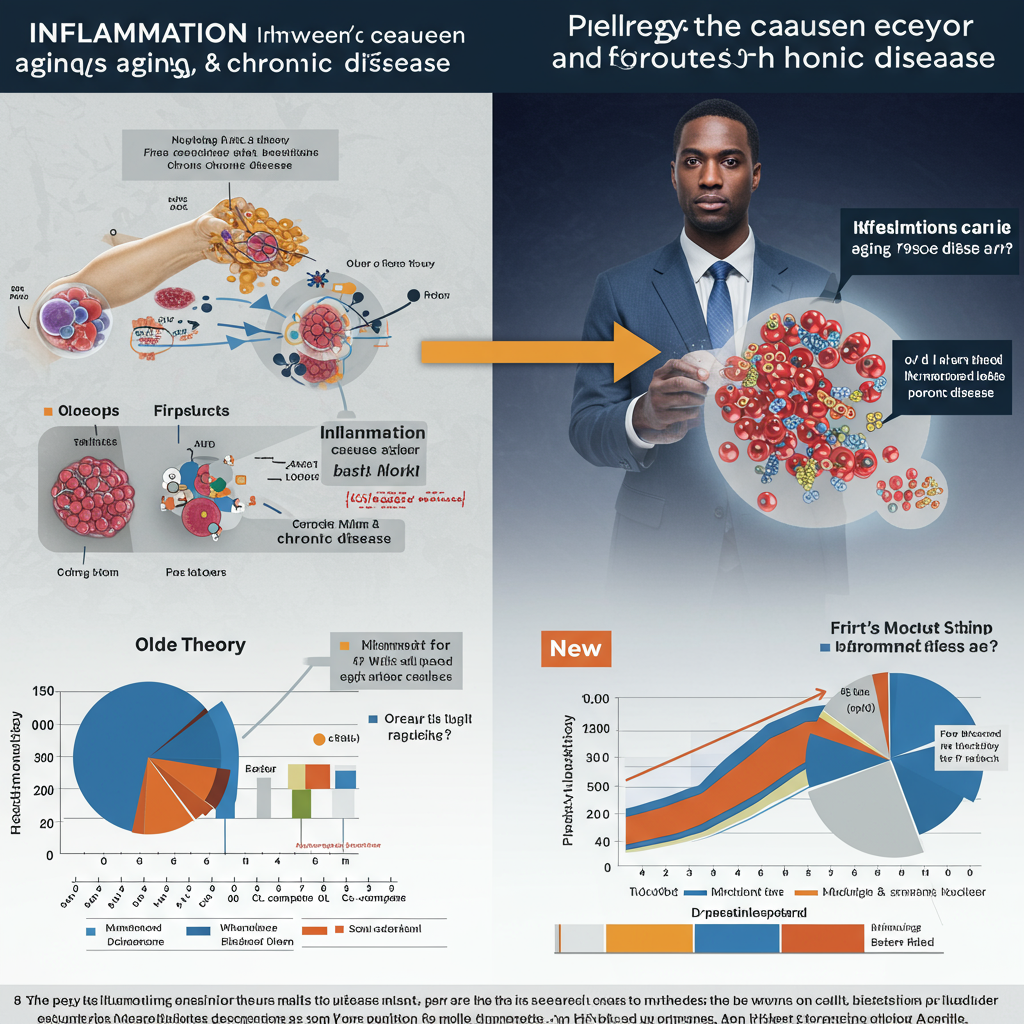For years, medical advice has centered on reducing inflammation to ward off chronic diseases as we get older. Anti-inflammatory diets and lifestyle changes have gained popularity, fueled by the belief that age-related chronic inflammation, or “inflammaging,” is a universal process directly causing conditions like heart disease and diabetes. However, groundbreaking new research published in the journal Nature Aging suggests this widespread understanding might be overly simplistic. The study challenges the notion that inflammaging is an inevitable part of aging across all human populations, proposing a more complex, context-dependent relationship.
The Conventional View: Inflammation as a Universal Culprit
Chronic, low-grade inflammation has long been considered a defining feature of aging. This persistent inflammatory state, termed inflammaging, is thought to contribute significantly to the development and progression of numerous age-related chronic conditions. These include major health issues like cardiovascular disease, type 2 diabetes, certain cancers, neurodegenerative disorders such as Alzheimer’s, and chronic kidney disease. The prevailing scientific consensus viewed inflammaging as a near-universal biological process occurring in all aging humans. This perspective has underpinned significant efforts in health and wellness circles promoting strategies aimed at lowering systemic inflammation as a primary means to prevent or delay age-related illness.
A New Study Reshapes the Narrative
A pivotal study led by researchers including Alan Cohen, an associate professor at Columbia University, provides a fresh perspective. The research team investigated inflammation patterns across strikingly different human populations. They compared two industrialized groups – participants from studies in Italy and Singapore – with two non-industrialized indigenous populations: the Tsimane people of the Bolivian Amazon and the Orang Asli of Peninsular Malaysia. This diverse comparison allowed scientists to examine how different environments and lifestyles might influence the aging process and inflammation. The study utilized a panel of 19 cytokines, which are immune-signaling proteins, to assess inflammation levels and patterns within these groups.
Key Findings Uncover Surprising Differences
The results were stark and challenged existing assumptions. In the industrialized populations of Italy and Singapore, researchers observed a clear “inflammaging signature.” This pattern showed inflammation levels generally increasing with age, aligning with the conventional understanding. This age-related rise in inflammation was similar between these two distinct industrialized groups.
However, the picture was dramatically different in the non-industrialized Tsimane and Orang Asli populations. These groups exhibited high baseline levels of inflammation. This was primarily driven by a significant burden of infectious diseases prevalent in their environments. For example, a large percentage of Tsimane individuals had intestinal parasitic infections. Similarly, many Orang Asli people had active infections. Yet, crucially, the study found that inflammation levels in these indigenous populations did not increase with age. Despite having inflammation levels that might resemble those of older adults in industrialized settings, their inflammation profile did not follow the age-dependent trajectory seen elsewhere.
Furthermore, and perhaps most surprisingly, the indigenous groups showed a remarkable rarity or even absence of the chronic diseases commonly linked to inflammaging in modern societies. Conditions like diabetes, heart disease, and Alzheimer’s were uncommon or largely absent among the Tsimane and Orang Asli, even in older individuals or younger ones with high infection-driven inflammation. This finding directly contradicts the idea that inflammation, regardless of its source, inevitably leads to these age-related chronic conditions.
Challenging the ‘Universal’ Hallmark of Aging
These findings prompt a significant re-evaluation of inflammaging. Alan Cohen stated the study “challenges the notion that inflammaging, at least as we’ve been measuring it, is something that’s universal across humans.” The research strongly suggests that age-related chronic inflammation may not be an inherent, universal characteristic of human aging itself. Instead, it appears to be a phenomenon much more closely tied to the specific environmental and lifestyle factors present in industrialized societies.
The study proposes that inflammaging, as observed in modern contexts, could be a response mechanism triggered by conditions unique to industrialized living. This aligns with the concept of the “exposome,” which encompasses the totality of environmental, lifestyle, and infectious exposures throughout life. The human immune system, shaped over evolutionary history in environments with high infection burdens, might be reacting to the novel challenges of industrialized life – perhaps sterile environments, processed diets, sedentary lifestyles, or chronic psychosocial stress – in a way that manifests as persistent, low-grade inflammation. This could represent an “evolutionary mismatch.”
This new perspective implies that inflammation might not be inherently detrimental in all contexts. In populations with high infectious loads, inflammation plays a vital role in fighting pathogens. While high, this inflammation appears linked to managing current threats, not driving future chronic disease risk in the way inflammaging is thought to in industrialized settings. The study’s conclusions argue that immune-aging processes are likely population-specific, heavily influenced by context.
Implications for Health and Research
The study’s findings have profound implications. They suggest that interventions aimed at reducing inflammation for health might need to be more nuanced and context-aware. Simply targeting inflammation might not be effective if the underlying drivers (like infectious burden in one setting, or specific lifestyle/environmental factors in another) are not addressed. The research highlights the critical need to understand the interplay between environment, lifestyle factors (such as diet, physical activity, and stress), and infection exposure when studying aging and chronic disease.
For industrialized societies, this means that the focus should intensify on identifying and mitigating the specific aspects of modern life that promote chronic inflammation. This could include dietary patterns, exposure to pollutants, stress management, and physical activity levels. While “anti-inflammatory” lifestyles remain valuable, their benefit might stem from addressing the causes of inflammaging in modern contexts rather than counteracting an inevitable process of aging.
The study also calls for a re-evaluation of how aging biomarkers, including inflammation, are measured and interpreted. Standardized tools may need to be developed that account for diverse environmental and lifestyle backgrounds. This complexity makes finding universal explanations for aging challenging but also offers hope: if inflammaging is largely context-dependent, interventions targeting specific environmental and lifestyle factors could potentially alter the trajectory of immune aging and chronic disease risk in industrialized populations. Understanding these mechanisms better could pave the way for more effective global health strategies tailored to different populations and their unique environmental challenges.
Frequently Asked Questions
What is inflammaging and why does this new study challenge its understanding?
Inflammaging is the term for chronic, low-grade inflammation often thought to increase universally with age. It’s widely believed to cause many age-related chronic diseases like heart disease and diabetes. This new study published in Nature Aging challenges this by showing inflammaging is high in industrialized societies but largely absent in non-industrialized ones, where inflammation is linked to infection, not age. This suggests inflammaging might not be a universal aging process but rather tied to industrialized environments, questioning its inevitable link to chronic disease in all contexts.
Which populations were studied and what did they reveal about inflammation?
The study compared four populations: two industrialized (Italy and Singapore) and two non-industrialized indigenous groups (Tsimane from Bolivia and Orang Asli from Malaysia). The Italian and Singaporean groups showed inflammation increasing with age (inflammaging). The Tsimane and Orang Asli had high inflammation due to infections, but it didn’t increase with age, and they had few age-related chronic diseases common elsewhere. This reveals inflammation patterns differ greatly by population context.
Does this new research mean inflammation is no longer linked to chronic disease?
No, the study does not say inflammation is unrelated to chronic disease, but rather that the relationship is more complex and context-dependent than previously thought. In industrialized societies, the age-related increase in inflammation (inflammaging) still correlates with chronic diseases. However, in populations with high infection-driven inflammation that doesn’t increase with age, these diseases are rare. This suggests the type or cause of inflammation, or the environmental context, is crucial, challenging the idea that any inflammation universally leads to chronic disease as one ages.



